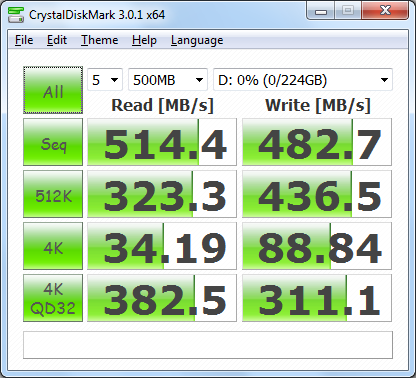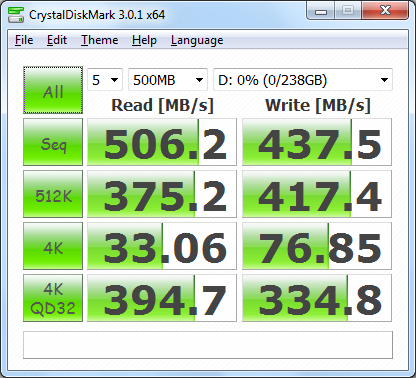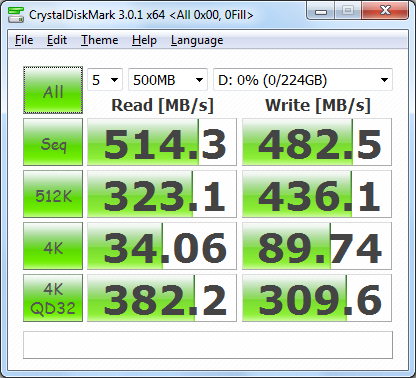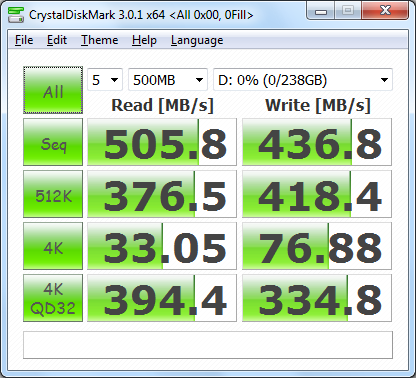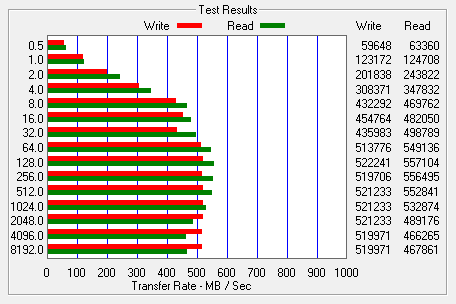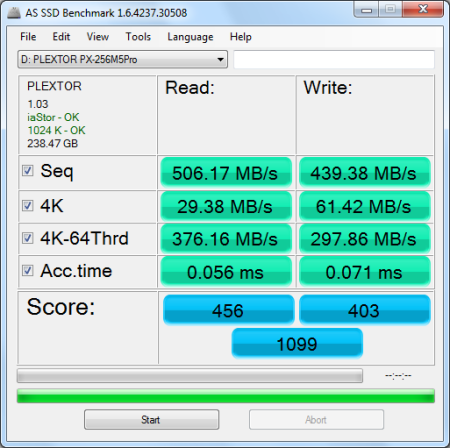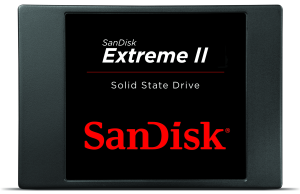

Model: SanDisk Extreme II 240GB Solid State Drive
Manufacturer: SanDisk
Provided By: SanDisk
SanDisk has been a leader in the storage industry for more than 20 years. Founded in 1988 by Dr. Eli Harari, the company has grown from a three-person Silicon Valley startup to the world's largest provider of flash memory storage solutions. The company offers a wide range of products including memory cards, USB flash drives, SSDs and its popular line of Sansa music and video players.
With the launch of the Extreme last spring, SanDisk made its long awaited entrance into the high-performance SSD market. Designed with enthusiasts and gamers in mind, the Extreme was powered by LSI's SandForce SF-2281 processor and featured a SATA 6GB/s interface, native TRIM support and DuraClass technology. The drive also used a custom firmware and SanDisk's own 24nm MLC Toggle Mode NAND flash to deliver speeds up to 10x faster than a 7,200 RPM hard disk drive.
At this year's Computex show, SanDisk unveiled the successor to the Extreme. Aptly named the Extreme II, this ultra-slim SSD is powered by Marvell's 88SS9187 "Monet" controller and is equipped with SanDisk's new 19nm eX2 ABL MLC Toggle NAND flash to deliver up to 550 MB/s sequential read and 510 MB/s sequential write speeds. The Extreme II also features a tiered caching system which includes a sizeable DRAM cache as well as support for SanDisk's nCache technology. Designed to improve random write performance, nCache uses a large non-volatile SLC cache to accumulate small writes at high speed and then flushes them to the larger MLC sections of the NAND flash memory array.

The Extreme II is available in 120GB, 240GB and 480GB capacities. For this review, SanDisk sent us the 240GB version of the drive which comes equipped with 256MB of on-board cache and is capable of delivering up to 550 MB/s sequential read and 510 MB/s sequential write speeds as well as up to 95,000 random read and 78,000 random write IOPS.
| SanDisk Extreme II 240GB Solid State Drive | |||||||||||||||||||||||||||||||||||||||||||||||
General Specifications
Performance
Reliability
Power Consumption
Environmental
Dimensions and Weight
Other Features
|
Needless to say, this is only a taste of what the Extreme II has to offer. To give you an idea of what to expect, we'll take a closer look at SanDisk's new SSD and then see how well it performs. Does the Extreme II have what it takes? Can it deliver the value and performance we've come to expect from SanDisk? Keep reading as we find out.
The Extreme II looks very similar to SanDisk's other 2.5-inch SSDs. The top of the outer casing is made out of black plastic with a large, black and red sticker showing that the SSD is part of the company's Extreme II series. The bottom of the casing is made out of metal and is painted black to match the top. The large sticker on the bottom covers the screws holding the drive together and shows information like the part number, capacity and serial number.
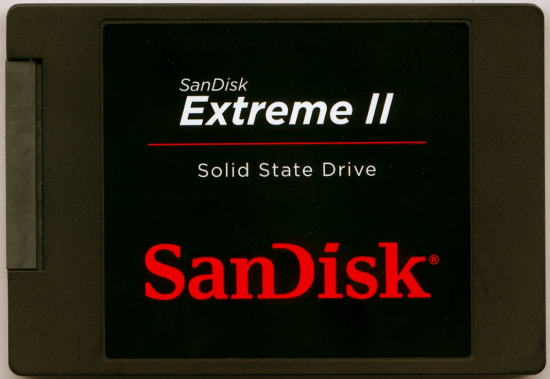

As I mentioned earlier, the Extreme II uses Marvell's 88SS9187 "Monet" controller. The 88SS9187 is powered by a dual-core Marvell 88FR102 V5 CPU and supports up to eight NAND flash channels. The controller also features a high-performance ECC engine with adaptive read and write scheme as well as on-chip RAID functionality.
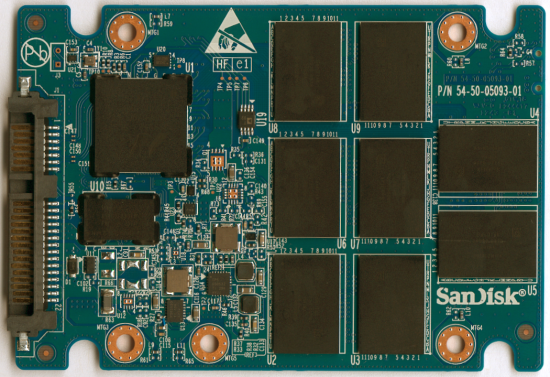

For the 240GB version of the Extreme II, SanDisk opted to use their own 32GB 19nm eX2 ABL MLC Toggle NAND flash chips. Looking at the picture above, you can see that there are eight of these chips on the top of the PCB. The drive also has a 256MB Hynix H5TQ2G63DFR DDR3 memory chip that is used for caching.
The test system used in this review was an HP 8200 Elite. The computer came equipped with an Intel Core i5-2400 CPU, 4GB of DDR3 1333MHz memory, Seagate Barracuda 7200.12 ST3250312AS 250GB SATA 6 Gb/s hard drive, NVIDIA Quadro FX580 512MB PCIe graphics card and an Intel 82579-LM gigabit network card. For the operating system, I installed a fresh copy of Windows 7 Enterprise.
To test the performance of the SanDisk Extreme II, I ran a series of benchmarks using CrystalDiskMark 3.0.1, HD Tach RW 3.0.4.0, ATTO Disk Benchmark 2.46, AS SSD, HD Tune Pro 4.61, Anvil's Storage Utilities and Iometer. For comparison, I've also included test results from the OCZ Vector, Plextor PX-256M5Pro Xtreme, Samsung SSD 840 Pro, Samsung SSD 840, Kingston Ultra Plus, OCZ Vertex 4, OCZ Agility 4, Kingston SSDNow V300, Kingston HyperX 3K and SanDisk Extreme.
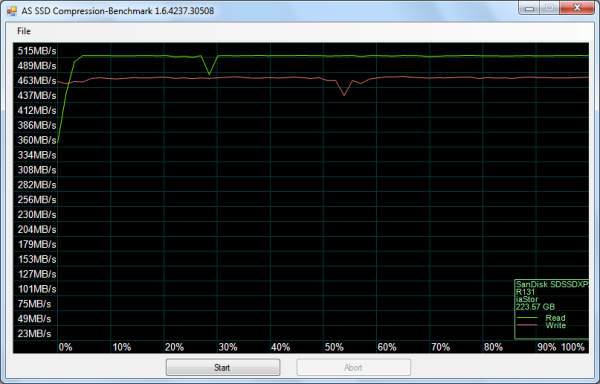
As I mentioned earlier, the Extreme II is based on Marvel's 88SS9187 controller chip. Looking at the screenshot above, you can see that it performs equally well with both incompressible (0%) and compressible (100%) data.
CrystalDiskMark 3.0.1:
First, I ran a few quick tests using CrystalDiskMark. This benchmark tool measures the performance of a storage device by testing its sequential read and write speeds as well as its random read and write speeds using blocks 512K and 4K in size.
According to SanDisk, the Extreme II is capable of reading at 550 MB/s and writing at 510 MB/s when connected to a SATA 6 Gb/s port. While the drive performed well, it came up a bit short of these numbers in CrystalDiskMark's sequential read and write speed tests.
The Extreme II performed equally well when using highly compressible 0x00 (0 Fill) data. This time around, the drive was able to read at 514.3 MB/s and write at 482.5 MB/s.
HD Tach RW 3.0.4.0:
Next, I used HD Tach to test the Extreme II's read, write and burst speeds as well as its seek times and CPU usage.
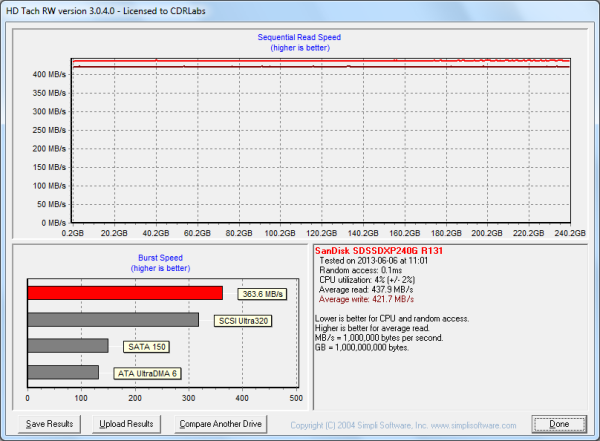
Looking at the screenshot above, you can see that the Extreme II had average read and write speeds of 437.9 MB/s and 421.7 MB/s respectively, as well as a burst speed of 363.6 MB/s.
ATTO Disk Benchmark 2.46:
I also used ATTO Disk Benchmark to test the Extreme II's sequential read and write speeds. The tests are run using blocks ranging in size from 0.5KB to 8192KB and the total length set to 256MB.
When tested with ATTO, the Extreme II's read speeds topped out at about 557 MB/s and its write speeds at 522 MB/s.
AS SSD:
AS SSD is a relatively new benchmark designed specifically for solid state drives. The application contains five synthetic tests used to determine the sequential and random read and write performance of a drive.
AS SSD also includes a copy benchmark. This test copies an ISO (two large files), program (many small files) and game (small and large files), returning the speed and duration of each.
HD Tune Pro 4.61:
Next, I ran a series of tests using HD Tune Pro. This hard disk utility measures a drive's performance by testing its sequential read and write speeds as well as its access time, burst rate and CPU usage. For this review, I'm also going to use it to benchmark the Extreme II's random read and write speeds, random access times and the number of operations per second.
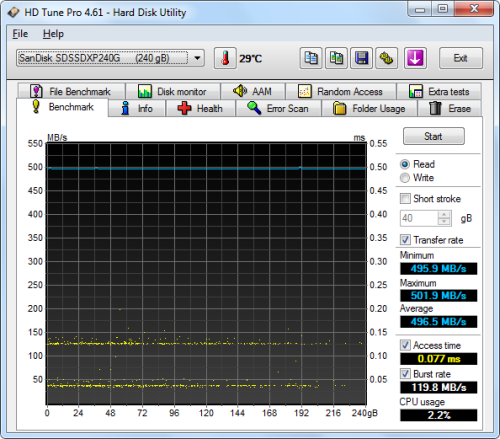 SanDisk Extreme II SSD 240GB - HD Tune Read Benchmark |
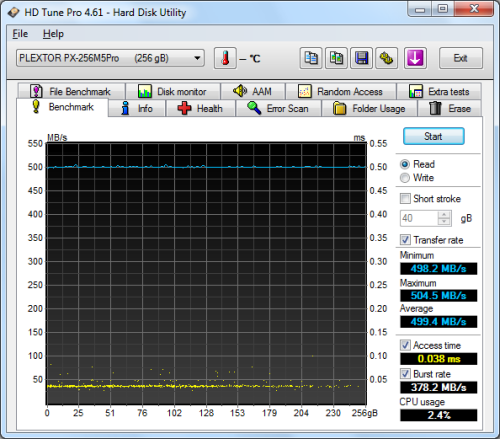 Plextor PX-256M5Pro Xtreme - HD Tune Read Benchmark |
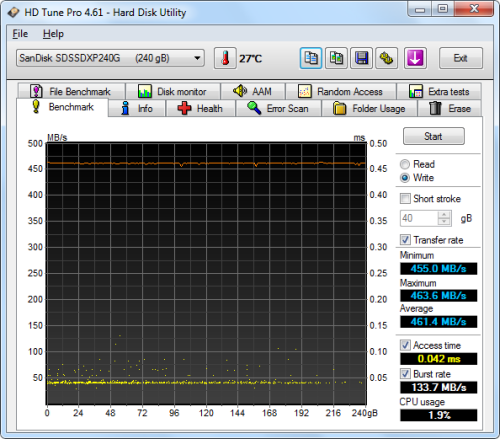 SanDisk Extreme II SSD 240GB - HD Tune Write Benchmark |
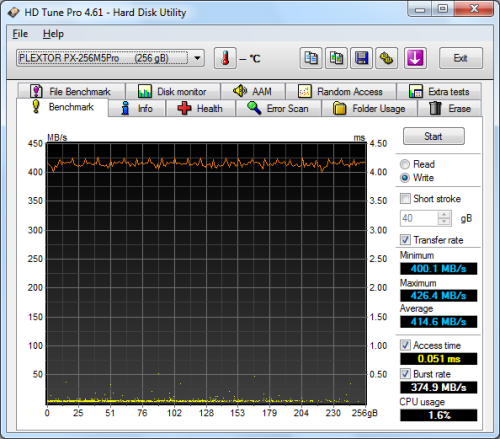 Plextor PX-256M5Pro Xtreme - HD Tune Write Benchmark |
The Extreme II performed very well when benchmarked with HD Tune. The drive had average read and write speeds of 496.5 MB/s and 461.4 MB/s, respectively, and a burst rate of 119.8 MB/s when reading
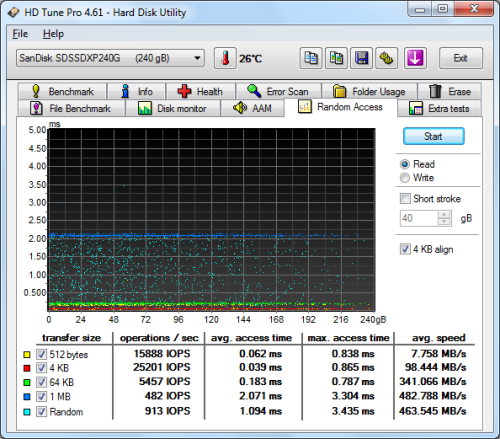 SanDisk Extreme II SSD 240GB - HD Tune Random Access Read |
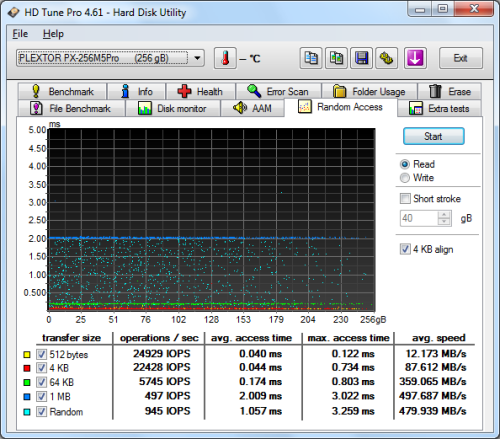 Plextor PX-256M5Pro Xtreme - HD Tune Random Access Read |
 SanDisk Extreme II SSD 240GB - HD Tune Random Access Write |
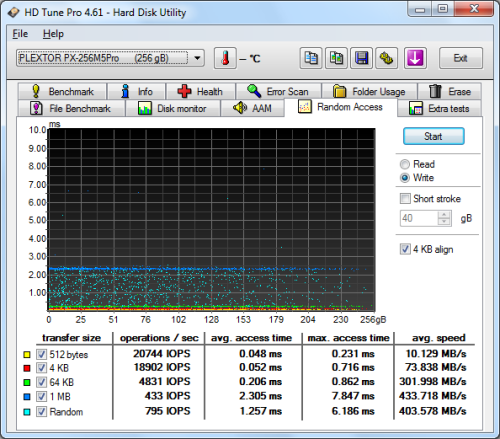 Plextor PX-256M5Pro Xtreme - HD Tune Random Access Write |
The Extreme II didn't disappoint when doing random reads and writes. When writing 4KB blocks, the drive reached 21,807 IOPS and had an average speed of 85.185 MB/s. The Extreme II was even faster when reading, reaching 25,201 IOPS with an average speed of 98.444 MB/s.
Anvil's Storage Utilities:
Anvil's Storage Utilities is another new benchmark designed with SSDs in mind. The standard storage benchmark measures a drive's performance by testing its transfer speeds, access times and IOPS.

Iometer:
Lastly, I ran a series of tests using Iometer. This tool can be configured to benchmark a number of things. In this case, I used it to measure the Extreme II's read and write speeds and the number of operations per second. The tests were run using random bytes and a queue depth of 3.

The Extreme II's performance was very similar to what we saw in our other tests. The drive was able to read at 528.32 MB/s and write at 489.82 MB/s.

The Extreme II also performed pretty well when doing random reads and writes. In our tests, the drive was able to read at 161.03 MB/s and write at 253.95 MB/s.

According to SanDisk, the 240GB Extreme II is capable of 95,000 IOPS when reading and 78,000 IOPS when writing 4K blocks. In our tests, the drive reached 41,223 random read IOPS and 65,012 random write IOPS. Increasing the queue depth had little impact on the Extreme II's random write performance. However, with the queue depth set to 32, the drive was able to reach 94,041 random read IOPS.
TRIM Performance:
While SSDs offer many benefits, there are some downsides to using flash memory. One of the biggest issues people run into is performance degradation. Over time, an SSD will run out of fresh blocks and will have to write over data the file system has marked as deleted. This procedure is very complicated and can slow an SSD's write speeds considerably.
To address this problem, most manufacturers have added TRIM support to their SSDs. The TRIM command allows an operating system, such as Windows 7, to tell an SSD which data blocks are no longer in use. Using this information, the drive pro-actively erases these blocks and adds them to the free block pool.
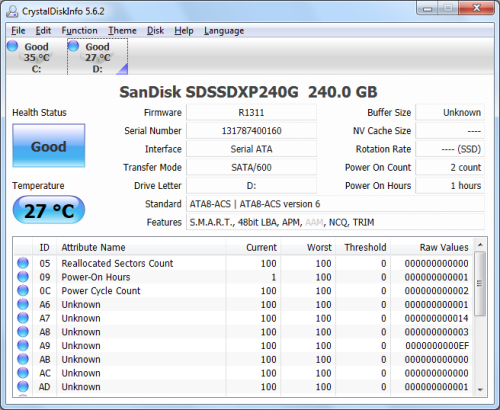
To test the Extreme II's TRIM function, I first put the drive in a "dirty" state. I used Iometer to fill the entire drive and then ran a random write test for 30 minutes. This had very little effect on the Extreme II's read speed. However, its average write speed dropped to 191.4 MB/s.
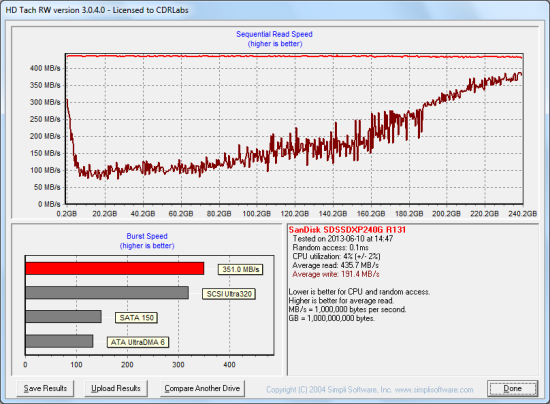
SanDisk Extreme II SSD - Dirty
To see how well the Extreme II could recover, I let the computer sit for a little more than an hour and then reran the test. The drive wasn't able to reach the factory fresh performance shown in our earlier tests. However, its average write speed climbed up to 410.5 MB/s.
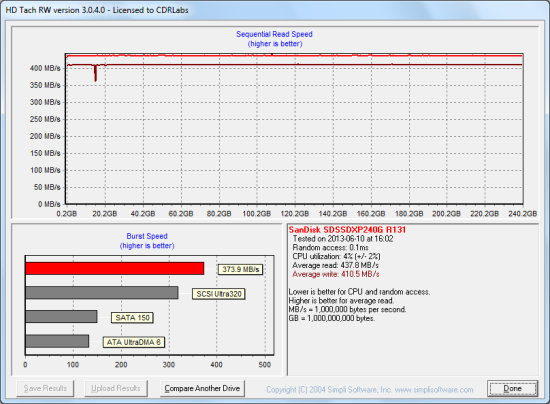
SanDisk Extreme II SSD - After Trim
Lastly, I used Parted Magic to perform a secure erase on the Extreme II. With the drive wiped clean, it had average read and write speeds of 448.7 MB/s and 410.5 MB/s, respectively.
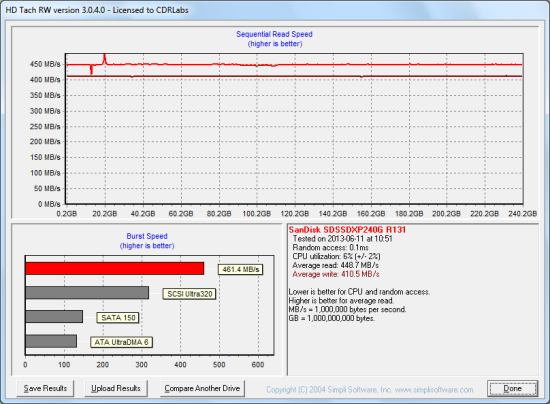
SanDisk Extreme II SSD - Secure Erase
Final Thoughts:
The Extreme II is SanDisk's fastest and most innovative SSD to date. Designed with gamers and enthusiasts in mind, this ultra-slim drive combines Marvell's 88SS9187 controller with SanDisk's own 19nm eX2 ABL MLC Toggle NAND flash to deliver a reliable and responsive computing experience. In our sequential read and write tests, the Extreme II was able to read at speeds as high as 557 MB/s and write at speeds in excess of 480 MB/s. Thanks to SanDisk's tiered caching system, it also did pretty well in our random write tests, producing more than 65,000 IOPS at low queue depths. Moreover, it performed equally well with compressible and incompressible data and was able to sustain these speeds, even after intensive use.
The SanDisk Extreme II is available now in 120GB, 240GB and 480GB capacities. Prices on Amazon.com currently range from $130 up to $450, with the 240GB version reviewed here going for about $230.

Highs:
- Available in 120GB, 240GB and 480GB capacities
- Marvell 88SS9187 controller
- nCache Technology
- Excellent sequential read and write speeds
- Good random read and write performance
- Performs equally well with compressible and incompressible data
- Consistent performance, even after intensive usage
- SATA 6Gb/s interface
- Toggle Mode NAND flash
- Large DRAM cache
- Supports TRIM, garbage collection and wear leveling
- Ultra-slim form factor
- 5 year warranty
Lows:
- Does not support hardware based encryption
- Pricey
